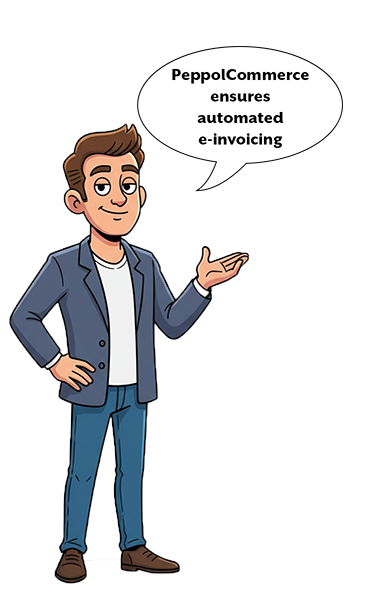Real-time e-invoicing for your webshop
Some WooCommerce entrepreneurs aiming for e-invoicing end up using tools such as Billit or LucySoftware. On first inspection, these connections seem simple and the platforms offer modern options for electronic invoicing via Peppol. However, in reality, the entrepreneur still carries a large part of the workload: exporting order details or invoices from WooCommerce, manually importing these files into Billit or LucySoftware, and only then generating the actual e-invoice to send to the customer.
This article investigates the impact of this workflow, the risks involved in such manual transfer of data, and demonstrates how the PeppolCommerce WooCommerce plugin completely eliminates these bottlenecks, delivering fully automated e-invoicing directly from each order—without extra manual actions.
The workflow of WooCommerce with Billit or LucySoftware
Imagine running a successful B2B WooCommerce webshop, receiving daily orders from business clients. To convert each order to a Peppol e-invoice, solutions like Billit or LucySoftware require you to follow this process:
While this workflow may seem straightforward, preparing each invoice requires at least five to ten minutes of the entrepreneur’s time. As order volumes grow, time loss increases rapidly for the business. And time wastage is not the only issue: manual handling of order data introduces errors, redundant steps, and added security risks.
Error Sensitivity and Invoicing Delays
Manually transferring data between WooCommerce and Billit or LucySoftware is highly prone to mistakes in daily practice. It’s easy to upload the wrong files, forget key details, or process an order twice by accident. This can result in
Any of these mistakes can directly impact your company’s cash flow and reputation. Customers expect speed, precision, and digital consistency. Manual steps make your processes fragile and less professional.

Security Risks of Manual Export and Import
Exporting order details from WooCommerce—often as a PDF—storing them locally, and then uploading to external platforms multiplies the points where sensitive data circulates. This can lead to documents getting lost, third-party access to company information, or data appearing in inappropriate places at the customer’s end. Security is essential, especially as European regulations around digital invoicing tighten.
WooCommerce with manual export vs PeppolCommerce
The contrast between these workflows is clear:
| Methodology | Separate invoicing platforms such as Billit or LucySoftware | PeppolCommerce WooCommerce Plugin |
|---|---|---|
| Order data | Manual export by the entrepreneur | Not needed – all data stays in WordPress |
| Invoice creation | Manual import by the entrepreneur into the invoicing platform | Not needed – all data stays in WordPress |
| E-invoice generation | Only possible after successful import | Immediate upon order placement |
| Error risk | High: missed orders, duplicate/incomplete invoices | Very low: fully real-time |
| Speed | Slow, depends on entrepreneur’s available time | Instant and automatic |
| Security | Multiple file paths and storage locations | Single, direct, secure Peppol flow |
Continuous Advantages of Automated Peppol Invoicing
With PeppolCommerce, invoicing is natively integrated into your B2B webshop. As soon as a customer places an order, the e-invoice is automatically generated in the correct UBL format and sent via Peppol. There are no extra exports, downloads, or uploads, and the entire chain remains digital and secure. The invoice lands directly in the client’s accounting system, facilitating quicker payment and processing.
This automation ensures that:
The entrepreneur’s perspective
As a B2B webshop owner, you want pace, transparency, and reliability in your invoicing. The manual workflow with Billit or LucySoftware may seem structured at first, but as your company expands, it quickly becomes clear that this approach inhibits scalability. You literally lose days or weeks per year to admin that could have been fully digital, and your entire process remains dependent on your own vigilance when transferring orders.
With PeppolCommerce, that extra admin disappears. Invoices move to the customer almost without intervention, remain consistent, and are instantly usable in any Peppol-compliant bookkeeping system. Your accounting, oversight, and cash flow become far more reliable and swift.
Cash Flow, compliance, and future-proofing
The trend towards digital e-invoicing and the mandatory use of Peppol invoices in Europe means that entrepreneurs who still rely on manual export/import workflows are likely to face growing pains in the near future. New legislation, such as in Belgium starting 2026, sets electronic Peppol invoices as the only acceptable standard for B2B transactions. Embracing a direct, automated solution now makes you not only compliant with the latest rules but also prepared to scale without extra administrative burden.
Conclusion
The combination of WooCommerce with Billit or LucySoftware remains a workflow based on manual export and import of order data—a system that is by definition inefficient, error-prone, and less secure. PeppolCommerce automates the entire invoicing process from your WooCommerce webshop, saving you time and expense, preventing errors, and guaranteeing compliance with European electronic invoicing requirements.
For a B2B entrepreneur, choosing direct Peppol integration is the key to streamlined administration, continuous business focus, and future-proof operations.







